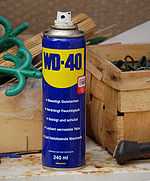WD-40
| Public (NASDAQ: WDFC) | |
| Industry | Chemical |
| Founded | 1953 |
| Headquarters | San Diego, California |
| Products | WD-40 |
| Website |
www |

WD-40 is the trademark name of a penetrating oil and water-displacing spray.
History
WD-40 was developed in 1953 by Norm Larsen,[1] founder of the Rocket Chemical Company, in San Diego, California. WD-40, abbreviated from the phrase "Water Displacement, 40th formula",[2] was originally designed to repel water and prevent corrosion,[3] and later was found to have numerous household uses.
Larsen was attempting to create a formula to prevent corrosion in nuclear missiles, by displacing the standing water that causes it. He claims he arrived at a successful formula on his 40th attempt.[3] WD-40 is primarily composed of various hydrocarbons.
WD-40 was first used by Convair to protect the outer skin and, more importantly, the paper-thin balloon tanks of the Atlas missile from rust and corrosion.[3][4] These stainless steel fuel tanks were so thin that, when empty, they had to be kept inflated with nitrogen gas to prevent their collapse.
WD-40 first became commercially available on store shelves in San Diego, California in 1958.[3]
Function
The long-term active ingredient is a non-volatile, viscous oil which remains on the surface, providing lubrication and protection from moisture.[5] This is diluted with a volatile hydrocarbon to give a low viscosity fluid which can be sprayed and thus penetrate crevices. The volatile hydrocarbon then evaporates, leaving the oil behind. A propellant (originally a low-molecular weight hydrocarbon, now carbon dioxide) provides gas pressure in the can to force the liquid through the spray nozzle, then evaporates away.
These properties make the product useful in both home and commercial fields; removing dirt and residue, and extricating stuck screws and bolts are common usages, and it also loosens stubborn zippers. It is also useful in displacing moisture.
Due to its lightness (i.e., low viscosity), WD-40 is not always the preferred oil for certain applications. Applications that require higher viscosity oils may use motor oils, while those requiring a mid-range oil could use honing oil.[6]
Formulation
WD-40's formula is a trade secret. The product was not patented in 1953 to avoid disclosing the details of its composition; the window of opportunity for patenting the product has long since closed.[4][7] WD-40's main ingredients as supplied in aerosol cans, according to U.S. Material Safety Data Sheet information, are:
- 50% "aliphatic hydrocarbons". The manufacturer's website specifically claims that this fraction in the current formulation cannot be accurately referred to as Stoddard solvent, a similar mixture of hydrocarbons.[8]
- <25% petroleum base oil, presumably a mineral oil or light lubricating oil.
- 12-18% low vapor pressure aliphatic hydrocarbon, to reduce the viscosity for use in aerosols. This fraction evaporates during application.
- 2-3% carbon dioxide, presumably as a propellant, is now used instead of liquefied petroleum gas to reduce WD-40's considerable flammability.
- <10% inert ingredients.
The German version of the mandatory EU safety sheet lists the following safety-relevant ingredients:
- 60–80% heavy naphtha (a petroleum product used e.g. in wick type cigarette lighters), hydrogen treated
- 1–5% carbon dioxide
It further lists flammability and effects to the human skin when repeatedly exposed to WD-40 as risks when using WD-40. Nitrile rubber gloves and safety glasses should be used. (Ordinary rubber is ruined by repeated exposure to petroleum products.) Water is unsuitable for extinguishing burning WD-40.
Wired published an article giving the result of gas chromatography and mass spectroscopy, claiming that its ingredients also make it resistant to freezing.[9]
WD-40 company

Rocket Chemical Company was founded in 1953. In 1969, John S. Barry, on becoming President and CEO, changed the name to WD-40 Company after what was then its only product. John Barry, who died July 3, 2009, reportedly made the name change on the basis that the Rocket Chemical Company did not make rockets.[4][10] The company went public in 1973. Its NASDAQ stock symbol is (NASDAQ: WDFC). In recent years the WD-40 company has acquired several household-products companies, adding such brand names as 3-In-One Oil, Lava, Spot Shot, X-14, Carpet Fresh, and 2000 Flushes to its roster. The company still has its corporate offices in San Diego, California.[11] It now markets its products in more than 160 countries.
References
- ↑ Bobby Mercer (March 18, 2011). ManVentions: From Cruise Control to Cordless Drills - Inventions Men Can't Live Without. Adams Media. pp. 181–. ISBN 978-1-4405-1075-5. Retrieved June 28, 2013.
- ↑ "WD-40 Frequently Asked Questions". Wd40.com. Retrieved 2012-08-19.
- ↑ 3.0 3.1 3.2 3.3 "Our History". WD-40.
- ↑ 4.0 4.1 4.2 Martin, Douglas. "John S. Barry, Main Force Behind WD-40, Dies at 84". The New York Times, July 22, 2009.
- ↑ "WD-40 MSDS" (PDF). Retrieved 2012-08-19.
- ↑ What is Honing Oil? Complete Multi-tool Sharpening Kit. Swiss Army Supplies Website. 2011. Retrieved December 8, 2012.
- ↑ This also means that its composition can have been varied by the manufacturer in different countries and at different times.
- ↑ "WD-40 Facts and Myths". Retrieved 24 April 2014.
- ↑ Di Justo, Patrick (20 Apr 2009). "What's Inside WD-40? Superlube's Secret Sauce". Wired. Archived from the original on 1 Jan 2014. Retrieved 24 April 2014.
- ↑ John Barry dies at 84; former executive made WD-40 a household name LA Times Obituary
- ↑ Killion, Andy (April 9, 2007). "Revenue, Net Income Both Rise at WD-40". San Diego Business Journal. Archived from the original on September 27, 2007. Retrieved April 13, 2007.